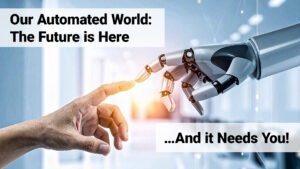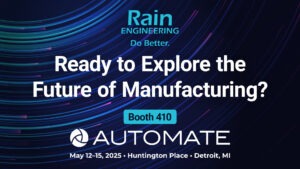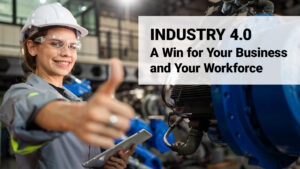
Our Automated World: The Future is Here (… And it Needs You!)
Our Automated World: The Future is Here (… And it Needs You!) AI and automation are no longer creeping into manufacturing—they’ve arrived, settled in, and
The manufacturing industry has undergone profound changes in recent decades, dramatically reshaping the experiences of workers, the nature of the work itself, and the expectations for the future workforce.
From the early days of manual labor to the rise of mechanized production, and now, to the era of advanced automation, the journey has been both revolutionary and empowering for workers.
As someone who has lived through this transformation or as someone who is perhaps looking to the future, understanding how far we’ve come—and where we’re headed—is crucial for preparing ourselves and future generations of workers.
Today, let’s prepare for the future by reviewing our past…
Let’s take a look at the changes our industry has seen just over the course of a single lifetime and what that could tell us about where we are heading in the years to come.
For much of the 20th century, the manufacturing industry was built on manual labor.
Factories buzzed with activity as workers performed repetitive tasks on assembly lines.
While this provided steady employment for millions of people and helped drive economic growth, the jobs were often physically demanding and monotonous.
As such, true, workers could count on job security and relatively predictable pay, but the work itself was far from revolutionary or creatively fulfilling.
At the time, automation had a limited presence, confined to basic mechanical machinery that could perform specific tasks.
Yes, these machines were helpful, but they did not dramatically change the nature of the work, allowing for the industrial workforce to be made up mostly of people who didn’t need specialized education or high-tech skills to do their jobs.
However, as manufacturing grew, it became increasingly clear that greater efficiency was needed to keep up with growing demand, and that’s where automation would eventually make its mark.
Fast forward to today, and automation has fundamentally changed the way manufacturing operates.
Modern factories are filled with robotic arms, automated assembly lines, and AI-powered systems that can perform tasks with incredible precision.
Automation in manufacturing is no longer just about replacing human labor for repetitive tasks; it’s about enhancing the workforce, improving safety, and increasing productivity.
Where once factories were powered by human hands, they are now driven by intelligent machines capable of doing more than simply completing a set of tasks.
Today’s robots, integrated with artificial intelligence (AI), machine learning, and real-time data analytics, not only follow orders—they learn from their environment, adapt to new situations, and optimize production processes in real-time.
For example, a worker operating a production line may now be overseeing an automated system that handles most of the repetitive work.
Robots can assemble parts, package goods, or inspect products with far more consistency than humans.
However, rather than replacing jobs, this type of automation frees up human workers to focus on tasks that require higher-level problem-solving, creativity, and innovation—areas where the uniquely human skill of ingenuity truly shines.
While automation has undeniably reduced the need for some types of manual labor, it has also created demand for new skills, shifting the focus from physical work to technical expertise.
Workers in today’s manufacturing industry must be able to manage, troubleshoot, and optimize automated systems.
While, yes, this shift has made it essential for workers to acquire new skills, such as knowledge of robotics, coding, and data analytics, in order to keep pace with technological advancements, it also has helped to create a more rewarding career for a newly upskilled workforce.
Automation has vastly improved the speed and efficiency of manufacturing. Machines work faster and with more precision than human workers can, reducing errors, speeding up production times, and allowing manufacturers to meet higher demand with fewer delays. The result is a more efficient factory floor that can produce more goods at lower costs.
Moreover, automation enables 24/7 production with minimal downtime, which is critical in industries that need to stay competitive. This capability is especially important as manufacturers try to meet the ever-increasing demand for faster delivery and just-in-time production models.
The benefits of automation extend beyond just productivity, it’s also improving worker safety. Many tasks in manufacturing can be hazardous, such as working with heavy machinery, welding, or handling toxic materials. Automation takes humans out of these dangerous environments by having robots and machines perform the risky work. This reduces the likelihood of workplace injuries and creates a safer working environment overall.
Robots, for instance, can perform repetitive lifting tasks, handle materials in hazardous environments, or work in extreme temperatures where human workers would be at risk. This shift not only saves lives but also reduces medical costs and time lost due to workplace injuries.
Automation also enhances product quality. Robots and AI systems can ensure that each product is made to exact specifications, eliminating human error in areas like assembly, quality control, and finishing. This results in fewer defects, less waste, and more consistent quality, which in turn drives customer satisfaction and brand loyalty.
In industries like automotive manufacturing, electronics, and pharmaceuticals, maintaining product quality is critical. Automation allows manufacturers to meet the strictest quality standards, even when producing large quantities, without compromising the integrity of the product.
Though automation requires a significant initial investment, the long-term cost benefits are substantial. The ability to reduce labor costs, improve efficiency, and minimize waste makes automation a cost-effective solution for manufacturers. Predictive maintenance, powered by AI, also helps prevent machine breakdowns, saving companies money in repairs and lost production time.
Automation allows for more precise control over resources, helping companies reduce material waste, improve energy efficiency, and streamline supply chains. These savings can then be reinvested into research, innovation, or workforce development.
As we look ahead, it’s clear that automation is here to stay, and its influence will only continue to grow.
The key to navigating this shift lies in how we prepare future generations of workers for the evolving manufacturing landscape.
Automation offers significant benefits to industries, but to fully embrace its potential, workers must adapt and enhance their skill sets.
As such, lifelong learning and upskilling will become central to workforce development.
The manufacturing jobs of tomorrow will require more than just manual labor; they will demand a deep understanding of emerging technologies such as robotics, data analytics, and AI.
Workers will need to be comfortable with new tools and systems, and ongoing education will ensure they remain competitive.
Educational programs, apprenticeships, and certification courses will help workers build the knowledge necessary to operate advanced systems, troubleshoot automated processes, and optimize production in real-time.
Such an evolving nature of technology means workers must be prepared for constant change.
Adapting to new tools and processes will be a vital part of every worker’s role in the future.
This means that we all will need to be flexible, ready to adjust to new software, systems, and automation methods as they arise.
In addition, embracing innovation and continuously seeking ways to improve through automation will be a key component to success.
If we approach change with curiosity and problem-solving skills instead of resentment and hesitation, we will be best positioned to take advantage of the opportunities that automation presents, leading to a more sustainable future for us all.
Yes, the manufacturing industry has certainly come a long way over the course of a single generation.
As the years progress and automation continues to reshape the industry, workers who are proactive about embracing technological advancements and continuously upgrading their skills will thrive.
By fostering adaptability, creativity, and a commitment to lifelong learning within the manufacturing community, we can all ensure that both current and future workers are well-equipped for the changing landscape of our industry.
Remember, the future of work in manufacturing is not about machines replacing people, it’s about people working alongside machines to build a better, more efficient, and more sustainable world for us all. (… And with the right preparation, both current and future workers can be part of it.)
P.S. Ready to secure your business’s future in manufacturing by continuing your team’s education?
Manufacturing KnowHow is Rain Engineering’s e-learning platform specially designed with today’s worker in mind.
Manufacturing KnowHow’s simple and inexpensive training gives you and your team the skills necessary to continue your promising careers in the manufacturing industry, surpassing the knowledge of your competitors who were not as forward thinking as you and solidifying your business’s value in the age of automation.
Don’t delay any longer.
Join Manufacturing KnowHow today!

Our Automated World: The Future is Here (… And it Needs You!) AI and automation are no longer creeping into manufacturing—they’ve arrived, settled in, and

Rare Earth Minerals and the Manufacturer’s Dilemma: How Global Politics and Critical Materials are Shaping the Future of American Industry In today’s industrial landscape, manufacturers

Manufacturing’s Quiet Crisis: The Generational Divide That’s Reshaping Industrial Work The manufacturing industry is standing on the edge of a transformation that reaches far beyond

Ready to Explore the Future of Manufacturing? As global markets become more volatile and customer demands shift faster than ever, manufacturers are at a critical

Trade Tensions Reloaded: What the Rising US-China Tariff War Could Mean for Manufacturers If you’re a U.S. manufacturer, you’ve already weathered your fair share of

Industry 4.0: A Win for Your Business and Your Workforce The manufacturing sector has always been the backbone of economies worldwide, but the current landscape
